For more information:
Note that the latest stuff may not yet be indexed.
The Klezmer Shack directory of articles
In the past few months, while I have been too busy to write full-scale reviews, a slew of excellent recordings have made their way to the KlezmerShack. The following is my attempt to right some of this imbalance by at least getting the word out. The order, unfortunately, is determined entirely by how they appeared after several times having the entire stack falling over and toppling onto the floor. The same randomized sampling means that some of these have been on the CD changer even longer, awaiting that moment when I would otherwise write the long, learned persuasive review. Sheesh.
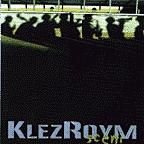 I posted this to the main KlezmerShack page last week, but it's still an exciting album that people should know about, even after it disappears "below the fold" on the KlezmerShack. Here's to a first listening (and second and third) to "Sceni," by Italy's "Klezroym," a band about whom I got very excited when their first release came out a few years ago. This second release, based on a quick first hearing, continued that Klezmer/Jewish-music based improvisational framework that caused the first album to stand out. Here, I think that they've gotten tighter. They also continue to feature the exquisite voice of Eva Coen. Despite some annoyingly bland English lyrics to something called "Klezmer Song," the band, and especially her voice take off on the rest of the recording. I draw special attention to a very well-done eastern-sounding "Morenica." Clearly influenced by the current high standard set by Israel's "Natural Gathering," (Ha Breira-Ha'tiv'it), KlezRoym still make it their own. For more info, contact the band, or the label, CNI, www.cnimusic.it. [GRADE: A]
I posted this to the main KlezmerShack page last week, but it's still an exciting album that people should know about, even after it disappears "below the fold" on the KlezmerShack. Here's to a first listening (and second and third) to "Sceni," by Italy's "Klezroym," a band about whom I got very excited when their first release came out a few years ago. This second release, based on a quick first hearing, continued that Klezmer/Jewish-music based improvisational framework that caused the first album to stand out. Here, I think that they've gotten tighter. They also continue to feature the exquisite voice of Eva Coen. Despite some annoyingly bland English lyrics to something called "Klezmer Song," the band, and especially her voice take off on the rest of the recording. I draw special attention to a very well-done eastern-sounding "Morenica." Clearly influenced by the current high standard set by Israel's "Natural Gathering," (Ha Breira-Ha'tiv'it), KlezRoym still make it their own. For more info, contact the band, or the label, CNI, www.cnimusic.it. [GRADE: A]
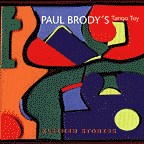 Paul Brody's Tango Toy "Klezmer Stories" (Laika 350122.2, 2000, www.laika-records.com) is a recording sure to be welcomed by those exploring the ground between klezmer and jazz. From the joyous opening, "Chava meets the Tango Man", followed by the more somber, "Klezmer in Black," this is a very, very nice jazz album with intriguing klezmer elements that somehow also retains good accessibility. It's intersection music--the excited voice of humanity at those places where many cultures come together and share, as on the especially lively "New Klezmer Band." Brody is an excellent trumpeter, and works well with an ensemble consisting of piano, bass, drums. This is a first listen, but already it fits my mind the way that a good Klezmokum album does, albeit, this ensemble also lacks vocals (to the better, in my opinion). Besides, how can one not be intrigued by an album whose closing number is "The schlemiel as a modern hero?" [GRADE: A, tentative]
Paul Brody's Tango Toy "Klezmer Stories" (Laika 350122.2, 2000, www.laika-records.com) is a recording sure to be welcomed by those exploring the ground between klezmer and jazz. From the joyous opening, "Chava meets the Tango Man", followed by the more somber, "Klezmer in Black," this is a very, very nice jazz album with intriguing klezmer elements that somehow also retains good accessibility. It's intersection music--the excited voice of humanity at those places where many cultures come together and share, as on the especially lively "New Klezmer Band." Brody is an excellent trumpeter, and works well with an ensemble consisting of piano, bass, drums. This is a first listen, but already it fits my mind the way that a good Klezmokum album does, albeit, this ensemble also lacks vocals (to the better, in my opinion). Besides, how can one not be intrigued by an album whose closing number is "The schlemiel as a modern hero?" [GRADE: A, tentative]
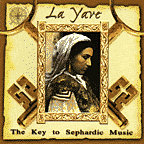 Switching genres entirely, I am really excited about a new Sephardic music anthology distributed in the US by Hatikva Music. Called "La Yave", the collection presents a very nice and rich collection of reasonably authentic recordings, ranging from the delightful Flory Jagoda, to Ruth Yaakov to Alhambra (both reviewed elsewhere on these pages), to the very Arabic-sounding Emil Zrihan, a cantor whose Piranha album has been a world music best-seller (and who was recently captured by a friend of mine on a late-night Israeli radio recording, "who is this voice? It's greaaat!"), and Eli Mellul or David Saltiel (the latter also mentioned on these pages), both recorded very much as they are, not prettied up with modern arrangements. The range of voice and song styles is astounding; the quality of the singers is uniformly outstanding, despite the age range from the young to those at their prime, to those who are clearly very old. This really is a key album for anyone who already knows the beauty of Sephardic song, or who wants to know what the fuss is about. [GRADE: A+]
Switching genres entirely, I am really excited about a new Sephardic music anthology distributed in the US by Hatikva Music. Called "La Yave", the collection presents a very nice and rich collection of reasonably authentic recordings, ranging from the delightful Flory Jagoda, to Ruth Yaakov to Alhambra (both reviewed elsewhere on these pages), to the very Arabic-sounding Emil Zrihan, a cantor whose Piranha album has been a world music best-seller (and who was recently captured by a friend of mine on a late-night Israeli radio recording, "who is this voice? It's greaaat!"), and Eli Mellul or David Saltiel (the latter also mentioned on these pages), both recorded very much as they are, not prettied up with modern arrangements. The range of voice and song styles is astounding; the quality of the singers is uniformly outstanding, despite the age range from the young to those at their prime, to those who are clearly very old. This really is a key album for anyone who already knows the beauty of Sephardic song, or who wants to know what the fuss is about. [GRADE: A+]
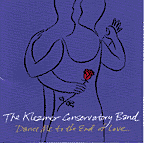 When I listen to a new Klezmer Conservatory Band album, "Dance me to the end of love," I have the same feeling of well-being that I feel when the Epstein Brothers used to take the stage: this is a band that is so good, and has been doing this so long, that the notes don't just provide pleasure, they reinforce the secure feeling that listening to KCB is everything it's always been, but better and immediate and new again. And this album does strengthen that feeling of security. Like "Dancing in the Aisles" of a couple of years ago, this album is just so good, so mature, and yet, still so listenable, so promoting of dancing around the room, that I need to try to hold myself back, to prevent pure pleasure from turning to fulsome falseness. I'll try to do that, but right now, the very romantic "Dance me to the end of the love" is playing, and, if not strictly (or loosely) klezmer, the title song is perfect for taking a spin around the world with someone special. I'll be back shortly. Just remember this: Just because a band is very good at what it does, doesn't mean it has to shake you up each album. Sometimes, what is wonderful, is how well it reminds you that klezmer, like life, is for dancing. [GRADE: A+]
When I listen to a new Klezmer Conservatory Band album, "Dance me to the end of love," I have the same feeling of well-being that I feel when the Epstein Brothers used to take the stage: this is a band that is so good, and has been doing this so long, that the notes don't just provide pleasure, they reinforce the secure feeling that listening to KCB is everything it's always been, but better and immediate and new again. And this album does strengthen that feeling of security. Like "Dancing in the Aisles" of a couple of years ago, this album is just so good, so mature, and yet, still so listenable, so promoting of dancing around the room, that I need to try to hold myself back, to prevent pure pleasure from turning to fulsome falseness. I'll try to do that, but right now, the very romantic "Dance me to the end of the love" is playing, and, if not strictly (or loosely) klezmer, the title song is perfect for taking a spin around the world with someone special. I'll be back shortly. Just remember this: Just because a band is very good at what it does, doesn't mean it has to shake you up each album. Sometimes, what is wonderful, is how well it reminds you that klezmer, like life, is for dancing. [GRADE: A+]
 From Germany, The Ensemble DRAj brings us "Lieder aus den Ghettos" (Songs from the Ghettos), well-sung renditions of Jewish songs from the Holocaust. Singer Anette Krüger's voice is quite nice, and the backing by accordion and cello is slightly jazzy and very well-done. Although, perhaps overshadowed by recent albums such as the outstanding collaboration between Adrienne Cooper and Zalmen Mlotek, "Ghetto Tango", that have built on this material and added much, this album is still quite a pleasant fusion between Weillish cabaret, Jewish folk melody, and jazz. What I can't answer is whether or not we are far enough from the Holocaust that such material can be presented by in a non-Jewish, German context, as here, and reasonably be reviewed on the basis of how it sounds. Ethno Art Ruhr 20021 (2000). [GRADE: B]
From Germany, The Ensemble DRAj brings us "Lieder aus den Ghettos" (Songs from the Ghettos), well-sung renditions of Jewish songs from the Holocaust. Singer Anette Krüger's voice is quite nice, and the backing by accordion and cello is slightly jazzy and very well-done. Although, perhaps overshadowed by recent albums such as the outstanding collaboration between Adrienne Cooper and Zalmen Mlotek, "Ghetto Tango", that have built on this material and added much, this album is still quite a pleasant fusion between Weillish cabaret, Jewish folk melody, and jazz. What I can't answer is whether or not we are far enough from the Holocaust that such material can be presented by in a non-Jewish, German context, as here, and reasonably be reviewed on the basis of how it sounds. Ethno Art Ruhr 20021 (2000). [GRADE: B]
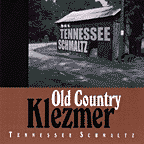 Moving back to the United States, we drive south to former US Presidential candidate Al Gore's homestate, Tennessee. (We note, in passing, that had Mr. Gore carried his own state, the vote in Florida would not have mattered in this particular election.). This has nothing to do, however, with the aptly named, "Tennessee Schmaltz," who have released their first album, "Old Country Klezmer" (2000). If you enjoy a lively selection of klezmer, Jewish, and Israeli tunes, performed in sdown-home arrangements with a lot of good, barnraising feeling, then this may be a good place to start. Sure enough, there are many hints of good southern bluegrass to lively things up further and suggest that you might want to bring the family on down and invite the band for your next simkha (celebration). [GRADE: B]
Moving back to the United States, we drive south to former US Presidential candidate Al Gore's homestate, Tennessee. (We note, in passing, that had Mr. Gore carried his own state, the vote in Florida would not have mattered in this particular election.). This has nothing to do, however, with the aptly named, "Tennessee Schmaltz," who have released their first album, "Old Country Klezmer" (2000). If you enjoy a lively selection of klezmer, Jewish, and Israeli tunes, performed in sdown-home arrangements with a lot of good, barnraising feeling, then this may be a good place to start. Sure enough, there are many hints of good southern bluegrass to lively things up further and suggest that you might want to bring the family on down and invite the band for your next simkha (celebration). [GRADE: B]
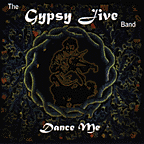 In a similar vein, in Owen Sound (uncomfortably far to the northwest of Toronto), Ottawa, Canada, the Gypsy Jive Band takes its own informal, "eclectic klezmer" approach to Jewish celebratory music. On their first album, "Dance Me", the band exhibits a homegrown and infectious sense of fun, starting with the album's opener, the slightly sardonic, slightly sad, "Eclectic Klezmer Blues". Moving through Yiddish song (with decent English translation), Fiddler on the Roof, swing jazz, the inevitable Cuando el Rey Nimrod, a Serbian dance, and Miserlou, the band demonstrates good voice, eclectic musicianship, and a darn good sense of fun. This is also the second band mentioned on this page to record "Dance me to the end of love", where I didn't know the song before. For that, and for that only, I defer to the abovementioned Klezmer Conservatory Band. These are nice people who also happen to make good music. They are also familiar with not only usual Jewish repertoire, but lots of the fun stuff on the fringes from other cultures. Such gypsies! Such a pleasure! We'll get a lot of joy from this one. No jive! (Additional points for an extraordinary album cover.) [GRADE: B]
In a similar vein, in Owen Sound (uncomfortably far to the northwest of Toronto), Ottawa, Canada, the Gypsy Jive Band takes its own informal, "eclectic klezmer" approach to Jewish celebratory music. On their first album, "Dance Me", the band exhibits a homegrown and infectious sense of fun, starting with the album's opener, the slightly sardonic, slightly sad, "Eclectic Klezmer Blues". Moving through Yiddish song (with decent English translation), Fiddler on the Roof, swing jazz, the inevitable Cuando el Rey Nimrod, a Serbian dance, and Miserlou, the band demonstrates good voice, eclectic musicianship, and a darn good sense of fun. This is also the second band mentioned on this page to record "Dance me to the end of love", where I didn't know the song before. For that, and for that only, I defer to the abovementioned Klezmer Conservatory Band. These are nice people who also happen to make good music. They are also familiar with not only usual Jewish repertoire, but lots of the fun stuff on the fringes from other cultures. Such gypsies! Such a pleasure! We'll get a lot of joy from this one. No jive! (Additional points for an extraordinary album cover.) [GRADE: B]
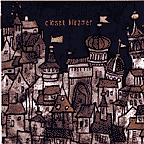 This eponymous album was sent to me back in 1998. It was only my third klezmer CD from down under, and I like it a lot. So I kept listening to it. And kept listening to it. It's about time I let Closet Klezmer out of the closet! The band, apparently from Canberra, does much traditional klezmer, and also includes some wonderful cuts from the Muzsikás album, "Máramaros: The Lost Jewish Music of
Transylvania". Tsimbl player Tim Meyen uses a tsimbl by Australian instrument-maker Gillian Alcock, so people looking for tsimbl-makers on that side of the world will especially want to hear someone this skilled take an Alcock through its paces. The vocalist does an Australian Yiddish very, very nicely on "Bei mir bist du shejn". Although I really like the musical ability of the band, there is a "chamber music" feel to this that changes the nature of the music from dance music to impeccably performed music to listen to at a library on a cold fall afternoon (like this afternoon). Were the band less talented, I might like the album less. Instead, I find myself appreciating a different approach to the music and still, these many years later, still listening. [GRADE: A-]
This eponymous album was sent to me back in 1998. It was only my third klezmer CD from down under, and I like it a lot. So I kept listening to it. And kept listening to it. It's about time I let Closet Klezmer out of the closet! The band, apparently from Canberra, does much traditional klezmer, and also includes some wonderful cuts from the Muzsikás album, "Máramaros: The Lost Jewish Music of
Transylvania". Tsimbl player Tim Meyen uses a tsimbl by Australian instrument-maker Gillian Alcock, so people looking for tsimbl-makers on that side of the world will especially want to hear someone this skilled take an Alcock through its paces. The vocalist does an Australian Yiddish very, very nicely on "Bei mir bist du shejn". Although I really like the musical ability of the band, there is a "chamber music" feel to this that changes the nature of the music from dance music to impeccably performed music to listen to at a library on a cold fall afternoon (like this afternoon). Were the band less talented, I might like the album less. Instead, I find myself appreciating a different approach to the music and still, these many years later, still listening. [GRADE: A-]
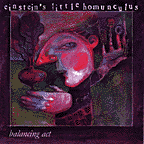 One of my favorite local Boston bands is a group of Frulgarian folkies named Einstein's Little Homunculus. Although not a klezmer band, Jews and Frulgarians have found common cultural cause for centuries, so it seems natural to include this second album, "Balancing Act" (Accordion School Music AS-0200) just as I reviewed the first, 1998's "Don't Ask." Not only that, but the percussionist demonstrated additional solidarity by showing up for our Sukkoth klezmer jam. What else could I do? Mind you, I'd probably even lie, just to spread the word about this little-publicized gem. I really like the way that the band has tied a college-age satiric sensibility to a world-aware sense of good, possibly in need of a spong, fun music. As before, my favorite pieces are the instrumentals, starting with the "gravel walk/tommy's tarbukas", the more celtic "farfel's/Steciak's," the balkan-celtic-klez "Skaista Gaida", and especially for another of the few examples of authentic flugarish music, "Fam Frulgar". The college students, of course, will not appreciate the "Practical Love Song" the way someone with my maturity does, but there's always the beets, and quiche, and more instrumentals. Now, I suppose I have to do what I did last time, and buy a stack of these to hand out to friends. Thanks, guys ... and don't forget to come back next party! Web: www.elh.org. Contact the band at elh.org. [GRADE: A]
One of my favorite local Boston bands is a group of Frulgarian folkies named Einstein's Little Homunculus. Although not a klezmer band, Jews and Frulgarians have found common cultural cause for centuries, so it seems natural to include this second album, "Balancing Act" (Accordion School Music AS-0200) just as I reviewed the first, 1998's "Don't Ask." Not only that, but the percussionist demonstrated additional solidarity by showing up for our Sukkoth klezmer jam. What else could I do? Mind you, I'd probably even lie, just to spread the word about this little-publicized gem. I really like the way that the band has tied a college-age satiric sensibility to a world-aware sense of good, possibly in need of a spong, fun music. As before, my favorite pieces are the instrumentals, starting with the "gravel walk/tommy's tarbukas", the more celtic "farfel's/Steciak's," the balkan-celtic-klez "Skaista Gaida", and especially for another of the few examples of authentic flugarish music, "Fam Frulgar". The college students, of course, will not appreciate the "Practical Love Song" the way someone with my maturity does, but there's always the beets, and quiche, and more instrumentals. Now, I suppose I have to do what I did last time, and buy a stack of these to hand out to friends. Thanks, guys ... and don't forget to come back next party! Web: www.elh.org. Contact the band at elh.org. [GRADE: A]
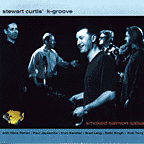 This is the first album by Stewart Curtis' latest band, the K-Groove. As he did on the previous outing (Too Loud for Dinner, 1995), Curtis takes mostly Jewish melodies, adds jazz and a touch of funk, and turns out a very pleasant dance sound. But for the dance rhythms, this reminds me a bit of 1970s Deodata or Herbie Mann. But they never had song titles like "Sketches of Chrane" (chrane=horseradish) or "Chicken Soup with Spots", and Ma'oz Tsur has needed something like "Mo's Hacksaw" for many generations. Still, the music also attracted the attention of our 14-year-old, suggesting that Curtis has once again come up with a band that will be perfect at sounding like what the kids want at their holidays. [GRADE: B]
This is the first album by Stewart Curtis' latest band, the K-Groove. As he did on the previous outing (Too Loud for Dinner, 1995), Curtis takes mostly Jewish melodies, adds jazz and a touch of funk, and turns out a very pleasant dance sound. But for the dance rhythms, this reminds me a bit of 1970s Deodata or Herbie Mann. But they never had song titles like "Sketches of Chrane" (chrane=horseradish) or "Chicken Soup with Spots", and Ma'oz Tsur has needed something like "Mo's Hacksaw" for many generations. Still, the music also attracted the attention of our 14-year-old, suggesting that Curtis has once again come up with a band that will be perfect at sounding like what the kids want at their holidays. [GRADE: B]
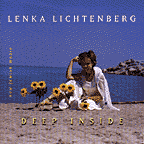 Although I have heard her sing briefly at the last couple of Ashkenaz Festival in Toronto, I haven't had a chance to listen to Lenka Lichtenberg's music more deeply until the arrival of this new CD, "Deep Inside". I think what I especially like is the way that she has written songs that address many of the issues that face us as Jews, from the perspective of a liberal, non-Orthodox Jewish person. It is appropriate, therefore, that she call it "new Jewish music" (there is also a harmonization in the term with the Ashkenaz fest billing, "new Yiddish music"). The melodies are familiar folk fare. Her voice is quite good. Backup includes familiar Toronto musicians, including some of my favorite Flying Bulgars and percussionist Rich Lazar. Although there are certainly traditional songs here, such as the familiar sephardic "Los Bilbilicos", or the Ashkenazic "Tum-Balalaike" to reinforce the sense of continuity and familiarity, Lichtenberg also manages to address the separatism of the ultra-Orthodox in "One day a conversation". It is also an album by someone, child of Holocaust survivors, who is seeing the possibility that contrary to pronouncements, obituaries for Yiddish may be premature, as in "Welcome back, Yiddish." In Lichtenberg's case, descended from thoroughly assimilated Jews who had celebrated four generations of Christmas, who didn't even know she was Jewish until she was 8, this is an especially big deal, if contrary to stereotype. (Thinking about raising children to speak Yiddish adds additional poignancy to the song about the ultra-Orthodox, whose children also speak Yiddish, but not to those outside the cult, but while such complexities, and more complex melodic and verbal fare appeal more to people like me, that may not be the case for the audience to whom this album is well-addressed.) In short, for parents with kids, this is an accessible, very pleasant album that both parent and child will enjoy, and which will give the parent something to think about. [GRADE: A-]
Although I have heard her sing briefly at the last couple of Ashkenaz Festival in Toronto, I haven't had a chance to listen to Lenka Lichtenberg's music more deeply until the arrival of this new CD, "Deep Inside". I think what I especially like is the way that she has written songs that address many of the issues that face us as Jews, from the perspective of a liberal, non-Orthodox Jewish person. It is appropriate, therefore, that she call it "new Jewish music" (there is also a harmonization in the term with the Ashkenaz fest billing, "new Yiddish music"). The melodies are familiar folk fare. Her voice is quite good. Backup includes familiar Toronto musicians, including some of my favorite Flying Bulgars and percussionist Rich Lazar. Although there are certainly traditional songs here, such as the familiar sephardic "Los Bilbilicos", or the Ashkenazic "Tum-Balalaike" to reinforce the sense of continuity and familiarity, Lichtenberg also manages to address the separatism of the ultra-Orthodox in "One day a conversation". It is also an album by someone, child of Holocaust survivors, who is seeing the possibility that contrary to pronouncements, obituaries for Yiddish may be premature, as in "Welcome back, Yiddish." In Lichtenberg's case, descended from thoroughly assimilated Jews who had celebrated four generations of Christmas, who didn't even know she was Jewish until she was 8, this is an especially big deal, if contrary to stereotype. (Thinking about raising children to speak Yiddish adds additional poignancy to the song about the ultra-Orthodox, whose children also speak Yiddish, but not to those outside the cult, but while such complexities, and more complex melodic and verbal fare appeal more to people like me, that may not be the case for the audience to whom this album is well-addressed.) In short, for parents with kids, this is an accessible, very pleasant album that both parent and child will enjoy, and which will give the parent something to think about. [GRADE: A-]
 Majer Bogdanski, worker, union organizer, and later in life, canter, is one of our treasures. Now in his Eighties? His nineties? (This is a secret? Why is such simple biographical data not on the CD liner notes?) He was a principal informant for Budowitz' latest album of the Jewish wedding cycle, "Wedding without a Bride." At the 3rd London International Jewish Music Festival, held this past summer, he gave recitals of workers' songs, as well as of traditional folk songs, that were high points of the gathering. Even at his advanced age, he has an amazing voice! I regret to say that the Majer Bogdanski of talent and achievement that so many of us met then, is not the person recording, under less than optimal, slightly echo-y, conditions here, on this album of "Yiddish Songs Yidishe Lider" (JMHR CD 017). Still, there is no choice. This is what there is. Many of the songs recorded here were never recorded elsewhere. If one compares this recording to, say, field recordings by the Smithsonian, it is great. But, how he was recorded so poorly, in such poor voice, at home, with modern equipment at hand, is beyond me. Similarly, there is a wonderful interview of Bogdanski included, but nothing to indicate which/all? of these are his songs, traditional songs, songs by other specific authors, or where they fit in with his personal repertoire. Most unfortunately, even when it comes to the words of the songs, the apparently copious CD notes work against you. The Yiddish print is moved to the end of the booklet, away from the English or transliteration, the better, I guess, to prevent anyone from making use of it who isn't fully fluent in Yiddish. That figures because the typesetter set the Yiddish without vowels--usually considered a "no no" in Yiddish because only a few are used, and those that are, are considered part of the character. (That doesn't mean that no Yiddish is set without vowels, only that the standards specify it.) But, still, Majer Bogdanski is a national treasure, and while there is no end to critique in this recording, it is not a bad recording, compared to what it might have been, and there are at least some notes, where none might have been presented. I just don't understand, given the presence of a top class musicologist, Alex Knapp, the niceness and smartness of the people involved in production, and the facilities I saw in London, how so much was done so sloppy ... this presentation is unprofessional, through and through. Hard as it is to believe, there isn't even any recording info: when, by whom, using what, where? Such a treasure. Such a mess. Why? Contact Jewish Music Distribution, PO Box 67, Hailsham BN27 4UW, UK, e-mail: jmduk@hotmail.com. [GRADE A for the music; D- for notes, annotation, recording quality, and all the rest]
Majer Bogdanski, worker, union organizer, and later in life, canter, is one of our treasures. Now in his Eighties? His nineties? (This is a secret? Why is such simple biographical data not on the CD liner notes?) He was a principal informant for Budowitz' latest album of the Jewish wedding cycle, "Wedding without a Bride." At the 3rd London International Jewish Music Festival, held this past summer, he gave recitals of workers' songs, as well as of traditional folk songs, that were high points of the gathering. Even at his advanced age, he has an amazing voice! I regret to say that the Majer Bogdanski of talent and achievement that so many of us met then, is not the person recording, under less than optimal, slightly echo-y, conditions here, on this album of "Yiddish Songs Yidishe Lider" (JMHR CD 017). Still, there is no choice. This is what there is. Many of the songs recorded here were never recorded elsewhere. If one compares this recording to, say, field recordings by the Smithsonian, it is great. But, how he was recorded so poorly, in such poor voice, at home, with modern equipment at hand, is beyond me. Similarly, there is a wonderful interview of Bogdanski included, but nothing to indicate which/all? of these are his songs, traditional songs, songs by other specific authors, or where they fit in with his personal repertoire. Most unfortunately, even when it comes to the words of the songs, the apparently copious CD notes work against you. The Yiddish print is moved to the end of the booklet, away from the English or transliteration, the better, I guess, to prevent anyone from making use of it who isn't fully fluent in Yiddish. That figures because the typesetter set the Yiddish without vowels--usually considered a "no no" in Yiddish because only a few are used, and those that are, are considered part of the character. (That doesn't mean that no Yiddish is set without vowels, only that the standards specify it.) But, still, Majer Bogdanski is a national treasure, and while there is no end to critique in this recording, it is not a bad recording, compared to what it might have been, and there are at least some notes, where none might have been presented. I just don't understand, given the presence of a top class musicologist, Alex Knapp, the niceness and smartness of the people involved in production, and the facilities I saw in London, how so much was done so sloppy ... this presentation is unprofessional, through and through. Hard as it is to believe, there isn't even any recording info: when, by whom, using what, where? Such a treasure. Such a mess. Why? Contact Jewish Music Distribution, PO Box 67, Hailsham BN27 4UW, UK, e-mail: jmduk@hotmail.com. [GRADE A for the music; D- for notes, annotation, recording quality, and all the rest]
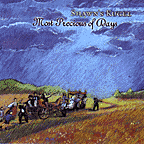 I'm rather fond of Shawn and of his potato kugel recipe. Also, of his band, Shawn's Kugel. This second album, "Most Precious of Days," continues that northwest coast US fusion of solid jazz and klezmer in a most appealing way. Along the way, he demonstrates how it all fits in with the kids in the thoroughly delightful "Az ikh vel zogn" (what the rest of us know as "Chiri Bom" or "Chiri Biri Bom") in which his wife, Cantor Wendy Marcus (formerly of the Mazeltones), and children, trade verses. And while the bass solo leading into "Der Heyser Bulger" may not be Jimmy Garrison on Coltrane's "Live in Seattle" album, it's still hot. And the following bulgar is hot, too. I also like the fact that Mr. Weaver is also writing new klezmer tunes. Most bands seem to be happy to do what they see in the cheat books, or to improvise on same. This band is happily within the tradition and writing within the tradition. They're also playing the full range of Jewish music as we know it today, from adaptations of religious tunes such as "Lecha Dodi", to the Sephardic "Jo Hanino" to the very Israeli "Hine ma tov" (here nicely funked up), to the not so Jewish, but quite welcome Skocne (or perhaps it is and I'm the uninformed) with its double dose of extra baritone sax to the closing "Dancing with Little Ones" medley, carrying on the tradition from the final Mazeltones album. [GRADE: A]
I'm rather fond of Shawn and of his potato kugel recipe. Also, of his band, Shawn's Kugel. This second album, "Most Precious of Days," continues that northwest coast US fusion of solid jazz and klezmer in a most appealing way. Along the way, he demonstrates how it all fits in with the kids in the thoroughly delightful "Az ikh vel zogn" (what the rest of us know as "Chiri Bom" or "Chiri Biri Bom") in which his wife, Cantor Wendy Marcus (formerly of the Mazeltones), and children, trade verses. And while the bass solo leading into "Der Heyser Bulger" may not be Jimmy Garrison on Coltrane's "Live in Seattle" album, it's still hot. And the following bulgar is hot, too. I also like the fact that Mr. Weaver is also writing new klezmer tunes. Most bands seem to be happy to do what they see in the cheat books, or to improvise on same. This band is happily within the tradition and writing within the tradition. They're also playing the full range of Jewish music as we know it today, from adaptations of religious tunes such as "Lecha Dodi", to the Sephardic "Jo Hanino" to the very Israeli "Hine ma tov" (here nicely funked up), to the not so Jewish, but quite welcome Skocne (or perhaps it is and I'm the uninformed) with its double dose of extra baritone sax to the closing "Dancing with Little Ones" medley, carrying on the tradition from the final Mazeltones album. [GRADE: A]
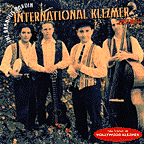 The Brandeis-Bardin International Klezmer Ensemble has been around several years, at least to my knowledge. Lately, they have also been appearing as a slicker band, Hollywood Klezmer, and have produced a second album under that name. Simon of Hatikva Music, reports that the second album is selling well and very popular, but, having just heard this first album, I have to say that it's my personal favorite among the two. This is amazingly solid, very traditional klezmer, played with that rare combination of enthusiasm and skill that makes music worth listening to on record (or CD, as the case may be). There are no surprises here--it's straight klezmer, with almost no singing (actually, the band chants at one point during the "Nigun"). But, as is often said, that's the surprise--very good music, played extraordinarily well, both in terms of the music, and in terms of soul. [GRADE: A]
The Brandeis-Bardin International Klezmer Ensemble has been around several years, at least to my knowledge. Lately, they have also been appearing as a slicker band, Hollywood Klezmer, and have produced a second album under that name. Simon of Hatikva Music, reports that the second album is selling well and very popular, but, having just heard this first album, I have to say that it's my personal favorite among the two. This is amazingly solid, very traditional klezmer, played with that rare combination of enthusiasm and skill that makes music worth listening to on record (or CD, as the case may be). There are no surprises here--it's straight klezmer, with almost no singing (actually, the band chants at one point during the "Nigun"). But, as is often said, that's the surprise--very good music, played extraordinarily well, both in terms of the music, and in terms of soul. [GRADE: A]
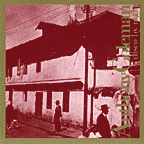 Andrew Coleman's "Sephardic Tinge" was the first release on Tzadik, and I reviewed it with pleasure, as soon as it came out in 1995. I've heard him play, live, since, with extreme pleasure. Then Hankus Netsky was talking about his old classmate and suggested that this album, "Disco by Night" was the one to listen to. To Hankus, this album speaks of Coleman's sense of "Jewish" in the specific sense of "Radical Jewish Music" and finding and expressing that return to Jewish. To me, as someone who loves Coleman's way of making music, and who is in love with Balkan music, as well as with some Jewish music, this album is the experimental fusion of both that sticks. Different reasons, but similar conclusion. (Did I mention that avant-accordion god, Guy Klucevsek also plays on this?) It's also a powerful statement of the fusion of language and culture that is the Balkans, as well as the intersection of history--most recently, communist-era reconstruction from WWII and then the fall of those regimes, and in the case of Yugoslavia, a descent into something horrible. This album largely predates the most recent wars. "Disco by Night" is a masterpiece. This is the album I've wanted to write about all day. This is the album I've been listening to every day for months, and may never find the time to write a serious, thoughtful review. The album itself, according to the liner notes, was composed during visits to Balkans, mostly in the '80s. As someone who treasures Balkan radio (especially after days in a car with bland Europop), who treasures the Balkans, and who will happily spend more time there, this album speaks layers and layers. At some point, I will have to write more, for now, you have been warned: This album is the experimental fusion masterpiece of this page of capsules. For this album, I might even give up the KCB album I reviewed earlier. But then, Dr. (soon?) Netsky is the director behind KCB, too. Thanks, Hankus, for both. [GRADE: A++]
Andrew Coleman's "Sephardic Tinge" was the first release on Tzadik, and I reviewed it with pleasure, as soon as it came out in 1995. I've heard him play, live, since, with extreme pleasure. Then Hankus Netsky was talking about his old classmate and suggested that this album, "Disco by Night" was the one to listen to. To Hankus, this album speaks of Coleman's sense of "Jewish" in the specific sense of "Radical Jewish Music" and finding and expressing that return to Jewish. To me, as someone who loves Coleman's way of making music, and who is in love with Balkan music, as well as with some Jewish music, this album is the experimental fusion of both that sticks. Different reasons, but similar conclusion. (Did I mention that avant-accordion god, Guy Klucevsek also plays on this?) It's also a powerful statement of the fusion of language and culture that is the Balkans, as well as the intersection of history--most recently, communist-era reconstruction from WWII and then the fall of those regimes, and in the case of Yugoslavia, a descent into something horrible. This album largely predates the most recent wars. "Disco by Night" is a masterpiece. This is the album I've wanted to write about all day. This is the album I've been listening to every day for months, and may never find the time to write a serious, thoughtful review. The album itself, according to the liner notes, was composed during visits to Balkans, mostly in the '80s. As someone who treasures Balkan radio (especially after days in a car with bland Europop), who treasures the Balkans, and who will happily spend more time there, this album speaks layers and layers. At some point, I will have to write more, for now, you have been warned: This album is the experimental fusion masterpiece of this page of capsules. For this album, I might even give up the KCB album I reviewed earlier. But then, Dr. (soon?) Netsky is the director behind KCB, too. Thanks, Hankus, for both. [GRADE: A++]

